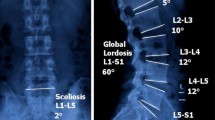Abstract
Purpose
The purpose of this study was to examine lumbar segmental mobility using kinetic magnetic resonance imaging (MRI) in patients with minimal lumbar spondylosis.
Methods
Mid-sagittal images of patients who underwent weight-bearing, multi-position kinetic MRI for symptomatic low back pain or radiculopathy were reviewed. Only patients with a Pfirrmann grade of I or II, indicating minimal disc disease, in all lumbar discs from L1–2 to L5–S1 were included for further analysis. Translational and angular motion was measured at each motion segment.
Results
The mean translational motion of the lumbar spine at each level was 1.38 mm at L1–L2, 1.41 mm at L2–L3, 1.14 mm at L3–L4, 1.10 mm at L4–L5 and 1.01 mm at L5–S1. Translational motion at L1–L2 and L2–L3 was significantly greater than L3–4, L4–L5 and L5–S1 levels (P < 0.007). The mean angular motion at each level was 7.34° at L1–L2, 8.56° at L2–L3, 8.34° at L3–L4, 8.87° at L4–L5, and 5.87° at L5–S1. The L5–S1 segment had significantly less angular motion when compared to all other levels (P < 0.006). The mean percentage contribution of each level to the total angular mobility of the lumbar spine was highest at L2–L3 (22.45 %) and least at L5/S1 (14.71 %) (P < 0.001).
Conclusion
In the current study, we evaluated lumbar segmental mobility in patients without significant degenerative disc disease and found that translational motion was greatest in the proximal lumbar levels whereas angular motion was similar in the mid-lumbar levels but decreased at L1–L2 and L5–S1.




Similar content being viewed by others
References
Kirkaldy-Willis WH, Farfan HF (1982) Instability of the lumbar spine. Clin Orthop Relat Res 165:110–123
Murata M, Morio Y, Kuranobu K (1994) Lumbar disc degeneration and segmental instability:a comparison of magnetic resonance images and plain radiographs of patients with low back pain. Arch Orthop Trauma Surg 113:297–301
Fujiwara A, Lim TH, An HS et al (2000) The effect of disc degeneration and facet joint osteoarthritis on the segmental flexibility of the lumbar spine. Spine 25:3036–3044
Iguchi T, Kanemura A, Kasahara K, Kurihara A, Doita M, Yoshiya S (2003) Age distribution of three radiologic factors for lumbar instability: probable aging process of the instability with disc degeneration. Spine 28:2628–2633
Frobin W, Brinckmann P, Leivseth G et al (1996) Precision measurement of segmental motion from flexion–extension radiographs of the lumbar spine. Clin Biomech (Bristol, Avon) 11:457–465
Ochia RS, Inoue N, Renner SM et al (2006) Three-dimensional in vivo measurement of lumbar spine segmental motion. Spine 31:2073–2078
Steffen T, Rubin R, Baramki HG, Antoniou J, Marchesi D, Aebi M (1996) A new technique for measuring lumbar segmental motion in vivo: method, accuracy, and preliminary results. Spine 22:156–166
Pfirrmann CW, Metzdorf A, Zanetti M et al (2001) Magnetic resonance classification of lumbar intervertebral disc degeneration. Spine 26:1873–1878
Kong MH, Hymanson HJ, Song KY, Chin DK, Cho YE, Yoon do H et al (2009) Kinetic magnetic resonance imaging analysis of abnormal segmental motion of the functional spine unit. J Neurosurg Spine 10:357–365
Kong MH, Morishita Y et al (2009) Lumbar segmental mobility according to the grade of the disc, the facet joint, the muscle, and the ligament pathology by using kinetic magnetic resonance imaging. Spine 34:2537–2544
Zou J, Yan H, Miyasaki M, Wei F, Hong SW, Yoon SH, Morishita Y, Wang JC (2008) Missed lumbar disc herniations diagnosed with kinetic magnetic resonance imaging. Spine 33(5):E140–E144
Fitzgerald GK, Wynveen KJ, Rheault W et al (1983) Objective assessment with establishment of normal values for lumbar spinal range of motion. Phys Ther 63:1776–1781
Harada M, Abumi K, Ito M et al (2000) Cineradiographic motion analysis of normal lumbar spine during forward and backward flexion. Spine 25:1932–1937
Okawa A, Shinomiya K, Komori H et al (1998) Dynamic motion study of the whole lumbar spine by videofluoroscopy. Spine 23:1743–1749
Kauppila LI, Eustace S, Kiel DP et al (1998) Degenerative displacement of lumbar vertebrae. A 25-year followup study in Framingham. Spine 23:1868–1874
Vogt MT, Rubin D, Valentin RS et al (1998) Lumbar spondylolisthesis and lower back symptoms in elderly white women. The Study of Osteoporotic Fractures. Spine 23:2640–2647
Karadimas EJ, Siddiqui M, Smith FW, Wardlaw D (2006) Positional MRI changes in supine versus sitting postures in patients with degenerative lumbar spine. J Spinal Disord Tech 19:495–500
Morishita Y, Ohta H, Naito M, Matsumoto Y, Huang G, Tatsumi M, Takemitsu Y, Kida H (2011) Kinematic evaluation of the adjacent segments after lumbar instrumented surgery: a comparison between rigid fusion and dynamic non-fusion stabilization. Eur Spine J 20(9):1480–1485
Lee CK (1988) Accelerated degeneration of the segment adjacent to a lumbar fusion. Spine 13:375–377
Park P, Garton HJ, Gala VC et al (2004) Adjacent segment disease after lumbar or lumbosacral fusion: review of the literature. Spine 29:1938–1944
Ghiselli G, Wang JC, Bhatia NN et al (2004) Adjacent segment degeneration in the lumbar spine. J Bone Joint Surg Am A 86:1497–1503
Lee CK, Langrana NA (1984) Lumbosacral spinal fusion: a biomechanical study. Spine 9:574–581
Weinhoffer SL, Guyer RD, Herbert M et al (1995) Intradiscal pressure measurements above an instrumented fusion. Spine 20:526–531
Umehara S, Zindrick MR, Patwardhan AG et al (2000) The biomechanical effect of postoperative hypolordosis in instrumented lumbar fusion on instrumented and adjacent spinal segments. Spine 25:1617–1624
Akamuru T, Kawahara N, Tim Yoon S et al (2003) Adjacent segment motion after simulated lumbar fusion in different sagittal alignments: a biomechanical analysis. Spine 28:1560–1566
Conflict of interest
None.
Author information
Authors and Affiliations
Corresponding author
Rights and permissions
About this article
Cite this article
Tan, Y., Aghdasi, B.G., Montgomery, S.R. et al. Kinetic magnetic resonance imaging analysis of lumbar segmental mobility in patients without significant spondylosis. Eur Spine J 21, 2673–2679 (2012). https://doi.org/10.1007/s00586-012-2387-8
Received:
Revised:
Accepted:
Published:
Issue Date:
DOI: https://doi.org/10.1007/s00586-012-2387-8




